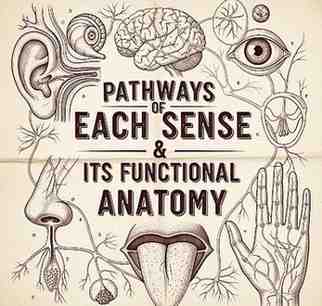
Your Account
Designed by Zeptt Technologies

The five Jnanendriyas (sense organs) in Ayurveda are responsible for perceiving the external world: Shrotra (ear), Tvak (skin), Chakshu (eye), Jihva (tongue), and Ghrana (nose).
These are linked to their respective Indriya-Dravyas (anatomical structures), Indriya-Abhimani Devatas (cognitive control centers), and sensory pathways described in both Ayurvedic and modern anatomical frameworks.
SHROTRENDRIYA (ORGAN OF HEARING)
AYURVEDIC VIEW
Shrotra is located in the Karna (ear) and functions through Akasha Mahabhuta.
It is supported by Vyana Vata, Tarpaka Kapha and Aalochaka Pitta.
Classical Reference:
चक्षुः श्रोत्रं घ्राणं जिह्वा त्वक् च
(Cha Sha 1/55 – five Jnanendriyas)
MODERN ANATOMY – AUDITORY PATHWAY (Ref: BD Chaurasia – Head and Neck)
Begins at the organ of Corti in the cochlea (inner ear).
Impulses carried by cochlear nerve, branch of CN VIII (Vestibulocochlear nerve).
Synapses in cochlear nuclei (medulla).
Crossed and uncrossed fibers ascend to inferior colliculus via lateral lemniscus.
Relay at medial geniculate body of thalamus.
Project to primary auditory cortex (Area 41 & 42) in temporal lobe.
CHAKSHURINDRIYA (ORGAN OF VISION)
AYURVEDIC VIEW
Chakshu is located in Netra and functions through Teja Mahabhuta.
Controlled by Aalochaka Pitta (particularly Drishti and Bhrajaka), and Tarpaka Kapha.
Classical Reference:
दृष्टिर्द्रष्टुर्दृशो दृष्टिः तस्यां संज्ञा प्रतिष्ठिता
(Sha Sa U 4/5)
MODERN ANATOMY – VISUAL PATHWAY (Ref: BD Chaurasia – Head and Neck)
Originates from photoreceptors in retina (rods & cones).
Impulses relayed via bipolar and ganglion cells.
Ganglion cell axons form optic nerve (CN II).
Partial crossing at optic chiasma.
Continue as optic tract to lateral geniculate body (LGB).
Fibers form optic radiation to visual cortex (Area 17) in occipital lobe.
TVAK INDRIYA (ORGAN OF TOUCH)
AYURVEDIC VIEW
Tvak (skin) perceives Sparsha (touch) through Vayu Mahabhuta.
Vata is responsible for tactile perception, supported by Bhrajaka Pitta.
Classical Reference:
सर्वेन्द्रियाणां न त्वगस्ति निःश्रेयसकरणे
(Cha Sha 1/72)
MODERN ANATOMY – TACTILE PATHWAY (Ref: BD Chaurasia – General Anatomy and CNS)
Receptors: Meissner’s corpuscles, Merkel’s discs, Pacinian corpuscles, free nerve endings.
First-order neurons: Cell bodies in dorsal root ganglia.
Second-order neurons: Located in dorsal column nuclei (gracile and cuneate).
Axons decussate and ascend via medial lemniscus.
Relay at ventral posterolateral (VPL) nucleus of thalamus.
Project to primary somatosensory cortex (Area 3,1,2) in parietal lobe.
JIHVENDRIYA (ORGAN OF TASTE)
AYURVEDIC VIEW
Jihva perceives Rasa (taste) through Aap Mahabhuta.
Function supported by Bodhaka Kapha and Aalochaka Pitta.
Classical Reference:
रसज्ञानेन जीह्वेयं ज्ञेया संज्ञावती सदा
(Ashtanga Hridaya)
MODERN ANATOMY – GUSTATORY PATHWAY (Ref: BD Chaurasia – Head and Neck)
Receptors in taste buds (fungiform, foliate, circumvallate papillae).
Anterior 2/3 – Facial nerve (CN VII) via chorda tympani.
Posterior 1/3 – Glossopharyngeal nerve (CN IX).
Base of tongue & epiglottis – Vagus nerve (CN X).
All synapse at nucleus of solitary tract in medulla.
Second-order neurons ascend to VPM of thalamus.
Project to gustatory cortex in insula and frontal operculum.
GHRAANENDRIYA (ORGAN OF SMELL)
AYURVEDIC VIEW
Ghrana is the organ for perceiving Gandha (smell), associated with Prithvi Mahabhuta.
Tarpaka Kapha maintains olfactory function.
Classical Reference:
घ्राणं गन्धविज्ञानं तत्र संज्ञा प्रतिष्ठिता
(Sha Sa U 4/5)
MODERN ANATOMY – OLFACTORY PATHWAY (Ref: BD Chaurasia – Head and Neck)
Begins at olfactory epithelium in nasal cavity.
Bipolar receptor neurons form olfactory nerve fibers (CN I).
Pass through cribriform plate to olfactory bulb.
Synapse in glomeruli with mitral & tufted cells.
Project via olfactory tract to primary olfactory cortex (piriform cortex, amygdala, entorhinal cortex) without thalamic relay.
SUMMARY TABLE
| Sense | Ayurvedic Organ | Modern Structure | Pathway Highlights |
|---|---|---|---|
| Hearing | Shrotra | Cochlea, CN VIII | Cochlear nuclei → Lateral lemniscus → MGB → Auditory cortex |
| Vision | Chakshu | Retina, CN II | Optic chiasma → LGB → Optic radiation → Visual cortex |
| Touch | Tvak | Skin receptors | Dorsal column → Medial lemniscus → VPL → Somatosensory cortex |
| Taste | Jihva | Taste buds, CN VII/IX/X | Nucleus solitarius → VPM → Gustatory cortex |
| Smell | Ghrana | Olfactory epithelium, CN I | Olfactory bulb → Tract → Primary olfactory cortex (no thalamus relay) |